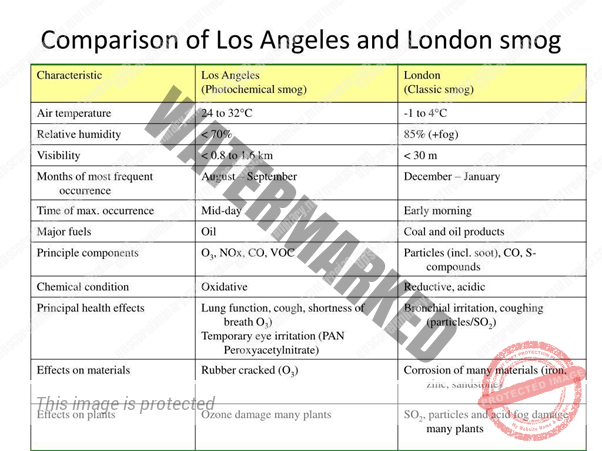- MECHANISM OF AIR POLLUTION IN THE ATMOSPHERE
- METEROLOGICAL CONDITIONS
- CLASSICAL SMOG AND PHOTOCHEMICAL SMOG
UNIT 4 – ENVIRONMENTAL DEGRADATION – PART 3
MECHANISM OF AIR POLLUTION IN THE ATMOSPHERE
Once pollutants enter the troposphere, they are transported downwind, diluted by the large volume of air, transformed through either physical or chemical changes or are removed from the atmosphere by rain during which they are attached to water vapour that subsequently forms rain or snow that falls to the earth’s surface.
The atmosphere normally disperses pollutants by mixing them in the very large volume of air that covers the earth. This dilutes the pollutants to acceptable levels. The rate of dispersion however varies in relation to the following aspects:
- Topography Normally as the earth’s surface becomes warmed by sunlight the layer of air in contact with the ground is also heated by convection. This warmer air is less dense than the cold air above it, so it rises. Thus pollutants produced in the surface layer are effectively dispersed.
- However on a still evening, the process is reversed. An hour or two before sunset after a sunny day, the ground starts to lose heat and the air near the ground begins to cool rapidly. Due to the absence of wind, a static layer of cold air is produced as the ground cools.
This in turn induces condensation of fog. The morning sun cannot initially penetrate this fog layer. Cold air being dense cannot rise and is trapped by the warm air above. It cannot move out of the area due to the surrounding hills. The topographic features resemble a closed chemical reactor in which the pollutants are trapped.
This condition often continues through the cool night and reaches its maximum intensity before sunrise. When the morning sun warms the ground the air near the ground also warms up and rises within an hour or two. This may be broken up by strong winds. In cold regions this situation can persist for several days. Such a situation is known as smog (smoke + fog).
- METEOROLOGICAL CONDITIONS – The velocity of the wind affects the dispersal of pollutants. Strong winds mix polluted air more rapidly with the surrounding air diluting the pollutants rapidly.
When wind velocity is low mixing takes place and the concentration of pollutants remains high.
The most well-known example is that of the ‘London Smog’ that occurred in 1952.
The city used large quantities of sulphur containing coal for domestic heating that released smoke, along with smoke from thermal power plants and when sulphur dioxide and nitrogen oxides are transported by prevailing winds they form secondary pollutants such as nitric acid vapour, droplets of sulfuric acid and particles of sulphate and nitrate salts.
These chemicals descend on the earth’s surface in two forms: wet (as acidic rain, snow, fog and cloud vapour) and dry (as acidic particles). The resulting mixture is called acid deposition, commonly called acid rain.
- CLASSICAL SMOG AND PHOTOCHEMICAL SMOG
Classical smog – Sulphureous smog is also called “London smog (it was first observed in London in 1952) or classical smog.
Sulphureous Smog results from a high concentration of Sulphur oxides in the air and is caused by the use of Sulphur bearing fossil fuels, particularly coal (Coal was the mains source of power in London during nineteenth century. The effects of coal burning were observed in early twentieth century).
This type of smog is aggravated by dampness and a high concentration of suspended particulate matter in the air.
Photochemical smog – Photochemical smog is also known as “LOS ANGELES SMOG” (it was first observed in Los Angles in 1943).
Photochemical smog occurs most prominently in urban areas that have large numbers of automobiles (Nitrogen oxides are the primary emissions). Photochemical (summer smog) forms when pollutants such as nitrogen oxides (primary pollutant) and organic compounds (primary pollutants) react together in the presence of sunlight. A gas called OZONE (Secondary pollutant) is formed.
Nitrogen Dioxide + Sunlight + Hydrocarbons = Ozone (Ozone in stratosphere it is beneficial, but near the earth’s surface it results in global warming as it is a greenhouse gas)

